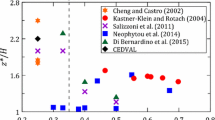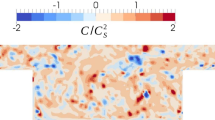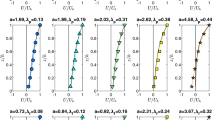Abstract
This paper deals with the modelling of the flow in the urban canopy layer. It critically reviews a well-known formula for the spatially-averaged wind profile, originally proposed by Cionco in 1965, and provides a new interpretation for it. This opens up a number of new applications for modelling mean wind flow over the neighbourhood scale. The model is based on a balance equation between the obstacle drag force and the local shear stress as proposed by Cionco for a vegetative canopy. The buildings within the canopy are represented as a canopy element drag formulated in terms of morphological parameters such as λ f and λ p (the ratios of plan area and frontal area of buildings to the lot area). These parameters can be obtained from the analysis of urban digital elevation models. The shear stress is parameterised using a mixing length approach. Spatially-averaged velocity profiles for different values of building packing density corresponding to different flow regimes are obtained and analysed. The computed solutions are compared with published data from wind-tunnel and water-tunnel experiments over arrays of cubes. The model is used to estimate the spatially-averaged velocity profile within and above neighbourhood areas of real cities by using vertical profiles of λ f .
Similar content being viewed by others
References
Allwine K, Clawson K, Leach M, Burrows D, Wayson R, Flaherty J, Allwine E (2004) Urban dispersion processes investigated during the Joint Urban 2003 study in Oklahoma City. In: Proceedings of the fifth conference on urban environment, Vancouver, British Columbia
Allwine K, Shinn J, Streit G, Clawson K, Brown M (2002) Overview of Urban 2000. Bull Am Meteorol Soc 83: 521–536
Arnold SJ, ApSimon H, Barlow J, Belcher S, Bell M, Boddy JW, Britter R, Cheng H, Clark R, Colvile RN, Dimitroulopoulou S, Dobre A, Greally B, Kaur S, Knights A, Lawton T, Makepeace A, Martin D, Neophytou M, Neville S, Nieuwenhuijsen M, Nickless G, Price C, Robins A, Shallcross D, Simmonds P, Smalley RJ, Tate J, Tomlin AS, Wang H, Walsh P (2004) Introduction to the DAPPLE air pollution project. Sci Tot Environ 332:139–153
Bentham T, Britter R (2003) Spatially averaged flow within obstacle arrays. Atmos Environ 37: 2037–2043
Britter R, Hanna S (2003) Flow and dispersion in urban areas. Ann Rev Fluid Mech 35: 469–496
Cheng H, Castro I (2001) Parameterisation of the roughness sublayer over cube array roughness. Technical report, University of Surrey. Internal Report ME-FD/01.108
Cionco R (1965) A mathematical model for air flow in a vegetative canopy. J Appl Meteorol 4: 517–522
Cionco R (1972) A wind-profile index for canopy flow. Boundary-Layer Meteorol 3: 255–263
Coceal O, Belcher S (2004) A canopy model for mean winds through urban areas. Quart J Roy Meteorol Soc 130: 1349–1372
Grimmond C, Oke T (1999) Aerodynamic properties of urban areas derived from analysis of surface form. J Appl Meteorol 38: 1261–1292
Hall D, Macdonald R, Walker S, Spanton A (1998) Measurements of dispersion within simulated urban arrays—a small scale wind-tunnel study. Technical Report BRE Client Report CR 244/98, Building Research Establishment (BRE)
Hamlyn D, Britter R (2005) A numerical study of the flow field and exchange processes within a canopy of urban-type roughness. Atmos Environ 39: 3243–3254
Hanna S, Tehranian S, Carissimo B, Macdonald R, Lohner R (2002) Comparisons of model simulations with observations of mean flow and turbulence within simple obstacle arrays. Atmos Environ 36: 541–507
Hunt J, Durbin P (1999) Perturbed vortical layers and shear sheltering. Fluid Dyn Res 24: 375–404
Jameson A, Schmidt W, Turkel E (1981) Numerical solution of the euler equations by finite volume methods using Runge-Kutta time-stepping schemes. In: AIAA 14th Fluid and Plasma Dynamic Conference, June 23–25, vol. AIAA 1981–1259. Palo Alto, CA pp 1–18
Kastner-Klein P, Rotach M, Fedorovich E (2000) Experimental study on mean flow and turbulence characteristics in an urban roughness sublayer. In: 14th Symp. Bound. Layer Turbul., Aspen, CO, 2000. Boston, MA, Am. Meteorol. Soc
Louka P (1998) Measurements of airflow in an urban environment. PhD Thesis. University of Reading, Reading, UK
Macdonald R (2000) Modelling the mean velocity profile in the Urban Canopy Layer. Boundary-Layer Meteorol 97: 25–45
Macdonald R, Carter S, Slawson P (2000) Measurements of mean velocity and turbulence statistics in simple obstacle arrays at 1:200 scale. Technical report. University of Waterloo, Thermal Fluids Report 2000-1
Macdonald R, Griffiths R, Hall D (1998) An improved method for estimation of surface roughness of obstacle arrays. Atmos Environ 32: 1857–1864
MATLAB (1997) MATLAB. The Math Works Inc. http://www.mathworks.com/
Mestayer P, Coll I (2005) The urban boundary layer field experiment over Marseille UBL/CLU-Escompte: experimental set-up and first results. Boundary-Layer Meteorol 114: 315–365
Müller C, Burian S, Brown M (1999) Urban database issues. Los Alamos National Laboratory, NM, LA-UR-99-5874
Oke T (1978) Boundary layer climates. John Wiley & Sons, New York, p 435
Ratti C, Di Sabatino S, Britter R (2006) Analysis of urban texture with image processing techniques: winds and dispersion. Theor Appl Climat 84: 77–90
Ratti C, Di Sabatino S, Britter R, Brown M, Caton F, Burian S (2002) Analysis of 3-D urban databases with respect to pollution dispersion for a number of European and American cities. J Water Soil Air Poll Focus 2: 459–469
Rotach M, Gryning S-E, Batchvarova E, Christen A, Vogt R (2004) Pollutant dispersion close to an urban surface-the BUBBLE tracer experiment. Meteorol Atmos Phys 87: 39–56
Roth M (2000) Review of atmospheric turbulence over cities. Quart J Roy Meteorol Soc 126: 941–990
Sykes RI, Parker S, Henn DS (2004) SCIPUFF Version 2.2. Technical Documentation. ARAP Report 728
Author information
Authors and Affiliations
Corresponding author
Rights and permissions
About this article
Cite this article
Di Sabatino, S., Solazzo, E., Paradisi, P. et al. A Simple Model for Spatially-averaged Wind Profiles Within and Above an Urban Canopy. Boundary-Layer Meteorol 127, 131–151 (2008). https://doi.org/10.1007/s10546-007-9250-1
Received:
Accepted:
Published:
Issue Date:
DOI: https://doi.org/10.1007/s10546-007-9250-1




